About Us


Since 1969, every aspect of the monument industry has changed. The one thing that remains the same is Design Mart's commitment to you and the families you serve. Design Mart has been adapting and growing with you for 50 years.
From hand-drawn monuments to digital design, technology has changed, but Design Mart's mission is still the same: To help the retailer provide a personal memorial and the best service possible.
![]()
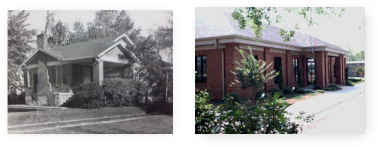
In 1969 the country anxiously watched as Neil Armstrong set foot on the moon. And in an old gasoline station in Elberton, Georgia, Design Mart was born.
Many things have changed since 1969, including the gas station location of Design Mart. While change occurs, commitment to quality is still the heart of what keeps Design Mart at the leading edge of the memorial marketing and sales industry.
As Design Mart grows and serves a new generation of memorial retailers more talent and space are required. Today, in our new facility, Design Mart has a team of artists, web developers and support staff ready to serve you.
![]()
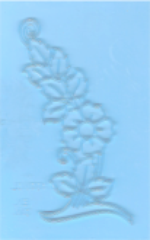
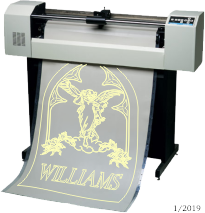 When Design Mart began, full-size pencil layouts on tracing paper, with chalk and carbon paper to transfer designs to stencil were high tech.
When Design Mart began, full-size pencil layouts on tracing paper, with chalk and carbon paper to transfer designs to stencil were high tech.
Next came plastic plates by 3M and others. These could be easily pressed into stencil, cutting it, so the sandblaster would pull the stencil and begin blasting and shaping. With a wide selection of DMart designs on plastic punch plates, everyone could design and produce personal monuments, but no one had to be an artist. In the late 80s and early 90s all our designs were digitized, and our artists are available to create custom artwork as seen here.

![]()
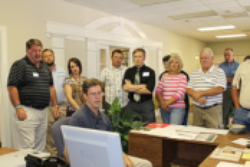
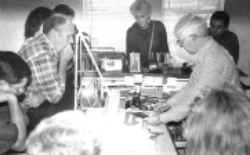
Design Mart believes in giving back to the monument industry. Each year we host the retail monument students who enrolled with the Elberton Granite Association. Retailers come from all over the United States to spend nearly a week in Elberton learning about granite, monument production, and sales. We have have been an EGA member since 1969, and we are proud to give back to these students who have traveled so far to improve their knowledge and make themselves the best retail memorialists they can be.
In the photo above, Joe Fernandez, founder of Design Mart, teaches one of the EGA’s retailer classes. This photo is from the late 70s or early 80s when monument images were still drawn by hand. Students were very interested in the many sketches, t-squares, curves, brushes, air brushes, and shades of ink required to make a design. At right, Mike Fernandez, who purchased Design Mart in the 90s, demonstrates the Online Monument Designer to another generation of memorialists.
![]()
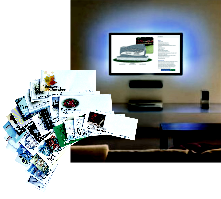
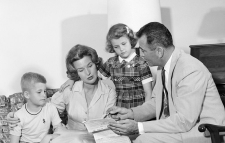
Our mission is simple: Provide the monument industry’s retailers with the materials and support they need to serve grieving families - providing a personal, meaningful memorial for generations to come.
Design prints, catalogs, and brochures were the norm until the 90s. That’s when web sites and digital design began to establish a foothold and forever change retail sales methods.
While Design Mart has sold more than 30 million brochures and 100,000+ catalogs, we remain at the leading edge of technology with the Online Monument Designer & Catalog. Selling and designing can be done in a sales room, cemetery, or home. All that’s needed is an internet connection.
![]()

Reaching more customers and growing your business doesn’t require a large budget. Simply put, families can’t purchase a monument from you unless they have heard of you. In the past, Yellow Pages and direct mail were the best ways to reach out to customers. Now it’s all about the web and social media. Design Mart has designed and continues to host hundreds of monument web sites. For those who already have web sites, we can connect our Legacy Online Catalog & Monument Designer to make browsing easier for the customer as well as the monument retailer.

History of Design Mart
Design Mart traces its roots back to 1920s when John Fernandez left Franco's dictatorship in Spain and arrived in Cuba. Soon after that, he took another voyage up the east coast and settled in Barre, Vermont where he worked in a growing granite industry. While in Barre, John worked for Jones Brothers, and was one of the craftsmen who created the well-known work at the center of downtown Barre. It was in Barre that he met and married Julia Pena before making their way south to Elberton, Georgia.
While two of their sons went into granite manufacturing, the other, Joe, went to work as an apprentice draftsman in several of Elberton's larger manufacturing companies. After working at Coggins Granite Industries and a stint in the US Army, he went to work for Ben Smith of Premier Designs where he perfected airbrush techniques that can be seen in all of DMart's early work. Joe opened Design Mart in 1969 in downtown Elberton and served the local industry with drafting services and realistic airbrushed renderings for manufacturer reps and retailers.
Tracing Design Mart's Roots: Summer Road Trip Includes Barre, Vermont
Design Mart traces its roots back to Spain at a time when Spanish dictator Francisco Franco saw thousands of citizens flee the censorship, coercion, imprisonment, concentration camps, forced labor, and heavy prison sentences, which characterized his regime.
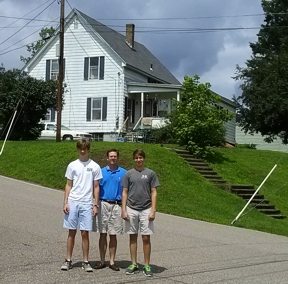
Mike and his sons, Christopher and Nicholas, stand in front of the house built by Luis Pena.
Among those entering the country via Ellis Island were the Penas, who went on to settle in Barre, Vermont. It was in Barre that Luis Pena went to work in Barre's granite industry. He and his wife Madelina, built a home, and raised five girls. One of them, Josephine, graduated from Spalding High School prior to her death at age 22.
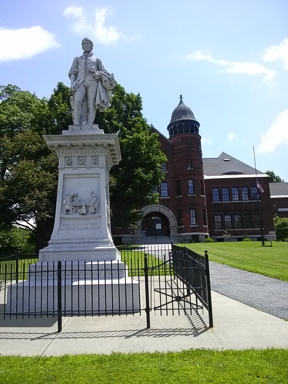
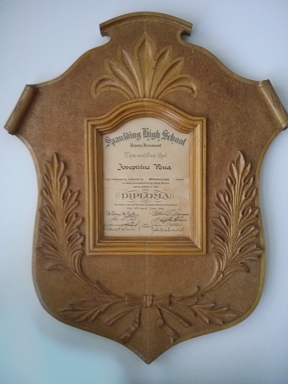
The form Spalding High School is now a beautiful museum in downtown Barre.
As pneumatic tools and sandblast came into use, granite dust took its toll on many sculptors. As Luis lay dying in Barre's sanitorium with silicosis and tuberculosis he joined together two pieces of maple wood and worked with a pocket knife, a piece of broken glass and a nail, to create a frame for Josephine's diplomma. Jospephine Pena's diploma remains inside the frame that was hand carved by Luis and is still on display at the home of Joe (Luis' grandson) and Katherine Fernandez in Elberton, Georgia. (At the bottom left corner is the signature of Deane C. Davis, who later served as Governor of Vermont.)
At about the same time, John Fernandez and his two brothers, Angel and Salustiano had left Spain for Cuba, and after learning of Barre's granite industry they made their way north.
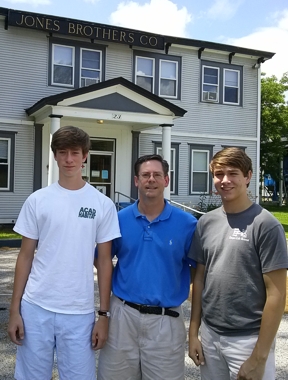
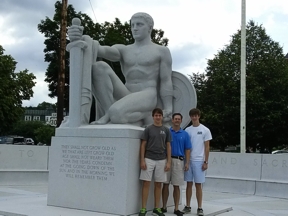
At the former Jones Brothers Company, and at Barre's WWI memorial.
Luis, John, Angel and Salustiano worked at Jones Brothers Granite Company where they crafted monuments that can be found in Barre's Hope and Elmwood Cemeteries.
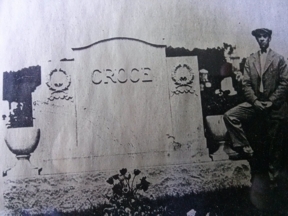
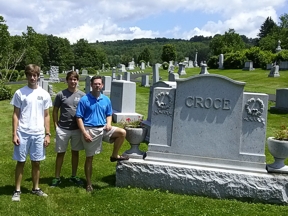
Then and now ... at Hope Cemetary.
After meeting Luis' daughter, Julia, John married her and moved south to Elberton, Georgia, as did John's brothers. They all went to work in Elberton's granite industry, and founded Victory Granite Company. John and Julia had four children, Manuel, Louise, Joe and John. The three brothers all worked in Elberton's granite industry, and in 1968, Joe founded Design Mart after working at Coggins Industries and Premier Designs.
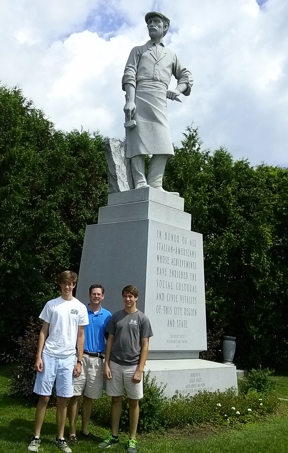
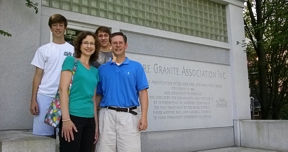
A monument ot Barre's immigrant craftsmen. The Barre Granite Association.
Joe Fernandez and his older son, Mike, continue Design Mart today - supplying thousands of monument retailers with brochures, catalogs, web sites, online sales and design tools, custom memorial artwork, and precut stencil.
Our Unique Approach
Design Mart's approach would be different from that of Premier Designs. Design firms had previously focused on individual photographically reproduced prints from a darkroom. Joe saw sales moving from a door-to-door task to one driven by targeted direct mail, and in 1969 started his own company - Design Mart. He compiled his design collections into brochures and matching sales books such as Precious Memories, A Closer Walk and Ties That Bind, which are still in demand today.
All Design Mart designs continue to carry unique identification numbers for monuments as well as components used to draw each monument. These numbers, coupled with a selection of alternate carvings in the back of each sales book make it possible for retailers and manufacturers to quickly customize monuments by number without guesswork.
Industry Revolution in 1970s
The mid 1970s saw a revolution in the pre-cutting of rubber sandblast stencil for carving and lettering on monuments. Sandblast masks made of heavy rubber had long been used to sandblast lettering, panels and flowers on monuments. Rubber was glued to the face of the granite monument and an actual size drawing was traced onto the rubber. After transfer, a cutter used a knife to hand-cut over the pencil lines that were transferred to the stencil. Rubber was then removed to reveal the stone underneath, which would be sandblasted.
Working with John Gaspari of Pall Limited (later PMD) and 3M, Design Mart aided in the development of a thin layer of mylar between the rubber and backing. Design Mart furnished popular component designs (flowers and panels) to be produced in plastic stencil cutting "punch plates" that acted like cookie cutters when pressed into the stencil under great pressure. The plate would press through and cut the stencil, but the mylar backing would stay in place. This made it possible for stencil to be pulled (or weeded) in the studio and then taken into the plant for application to the stone without a worker having to cut stencil by hand after it was applied to the stone. Stencil presses and plates were popular throughout the late 80s and early 90s when CAD systems were first used to cut stencil. The component identification process lent itself to an easy transition into the cut-and-paste world of digital clip art.
Technology Revolution in 1990s
In the early 90s Joe's son, Mike, returned to Elberton, and purchased Design Mart. By the mid 90s he had digitized many of Design Mart's popular design components that had been used as plastic plates. Complete monument designs formatted for CAD applications followed. Popular titles such as Precious Memories were the first to be digitized and led to the digitization of more than 25 different collections.
Companies such as Master Layout, Cochrans, Premier Designs and MonuCad all had their own collections that were sold with each system. Design Mart was the first company to offer CAD files in a variety of formats such as AI, EPS and DXF that were compatible with all CAD and illustration systems. For the first time, a company could use any established monument application as well as AutoCad, Illustrator, Corel and many others to open standard DMart designs and use them to cut sandblast stencil.
The mid 90s also led Design Mart to create many industry specific fonts in TrueType format such as Modified Roman, Condensed Roman and Vermarco. Users were no longer bound to a system with proprietary fonts such as Gerber or MonuCad.
The mid to late 90s also gave rise to email and websites. Manufacturers and retailers alike began ordering popular DMart CAD files by email. Design Mart created its first website and followed it with the creation of a site commissioned by the Elberton Granite Association. Today Design Mart hosts the third generation website for the EGA as well as hundreds of sites designed and built specifically for monument retailers.
Entering the 21st Century, Design Mart Leads Industry Innovation
After the year 2000 Design Mart created the industry's first click-and-drag monument design software, which ran from a CD and featured a basic selection of monument shapes, components, panels and fonts.
This was followed in 2006 by the online version of the Monument Designer, which allowed users to create colorful images of photo realistic monuments for sales presentations. All components were standards which made it easy for studio artists to build CAD files to match the images created by retailers. An online Catalog database was included in a subscription to the online Monument Designer and allowed users to search all DMart catalogs by monument or component number, family name or monument type and size.
In 2014 work began on Design Mart's new generation of online Monument Designer and Catalog. Several online design tools were on the market, but they only allowed the user to create an image of the monument. There was no CAD file created. Studio artists still had to create CAD files to match the monument portrayed in the image. Using Scalable Vector Graphics, Design Mart created a program that would render photo-realistic monument images while, at the same time, creating CAD files that were ready for stencil cutting.
Design Mart continues to cut pre-cut sandblast stencil and create customized digital artwork for the monument industry.
How Did They Do That?!
We’re bringing you a look at how presentation drawings were created in the past...long before CAD systems and Photoshop. It was all about pencils, pens, and airbrushes.
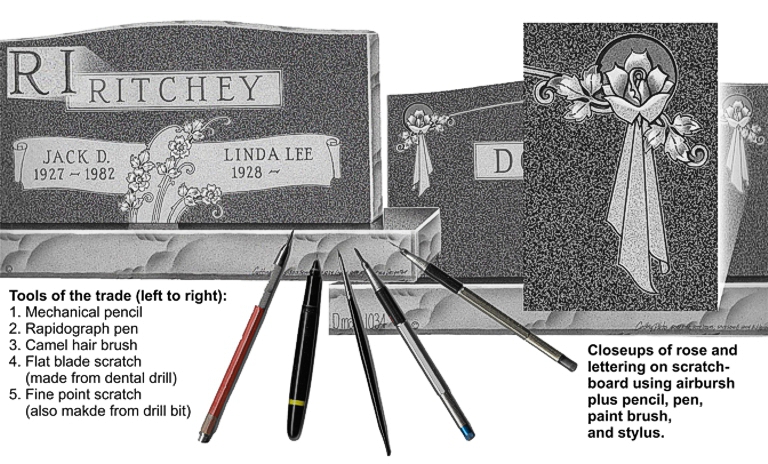
Roses & Leaves
In the enlarged carving shown on the top right of this image it is easy to see how the entire carving was frosted by airbrush. After that, sunken portions of a carving were given some additional ink from the same airbrush. When the ink dried, highlights were scratched onto the high points of the leaves and petals by lightly dragging a broad-blade stylus with microscopic teeth notched into it. Both the fine point stylus and the broad stylus were handmade from dental drill bits.
In the circle around the rose bloom, you’ll see that the shadow is heavier at the top left. That’s where the light source is located on every airbrushed Dmart design. A line is scratched around the entire carving to simulate the light reflected by the edge of the polish on each v-line. After zooming out, the highlights are almost imperceptible, but it’s one of the small things that makes Dmart presentations special.
Panels
Like carving, lettering, and all other aspects of a drawing, panels were first drawn by pencil on tracing paper using a triangle and T-square. After drawings were created and refined on tracing paper, a pencil was rubbed on the back of the tracing allowing a carbon paper-like transfer of the design to scratch board.
Inking was the first thing to be done on the scratch board. Panels and other lines drawn with logarithmic and French curves were drawn with a fine pen while smaller, tighter curves and letters were inked with a very fine camel hair brush.
Letters
Letters were transferred from the original drawing onto scratch board and a fine camel hair brush was used to create a light gray letter. Ink was diluted with water to match the shade of gray on all other Dmart designs. After the light gray wash dried, a darker gray was applied on the left side of every part of the letters to create a V-like appearance with the light source located at the top left. A stylus was used to scratch a highlight on the right side of the letters where light would catch the edge of the frosted surface.
Base Reflections & Highlights
Reflections were always applied to the polished tops of bases to simulate the mirror-like polish. In the design on the left of this image, the carving ends at the joint. This section of the frosted top of the base was masked off while polish was applied. When the mask was removed, the carving appeared to reflect on the polished top of the base.
The right sides of monuments and bases were always airbrushed and scratched to show reflective polish.
You’ll also notice the rock pitch on the right side of the base is slightly darker than the rock pitch on the front of the base, and the rock pitch on the side of the monument is slightly darker than the rock pitch on top of the monument. Like all other aspects of a Dmart design, everything was created with a light source located at the top left.
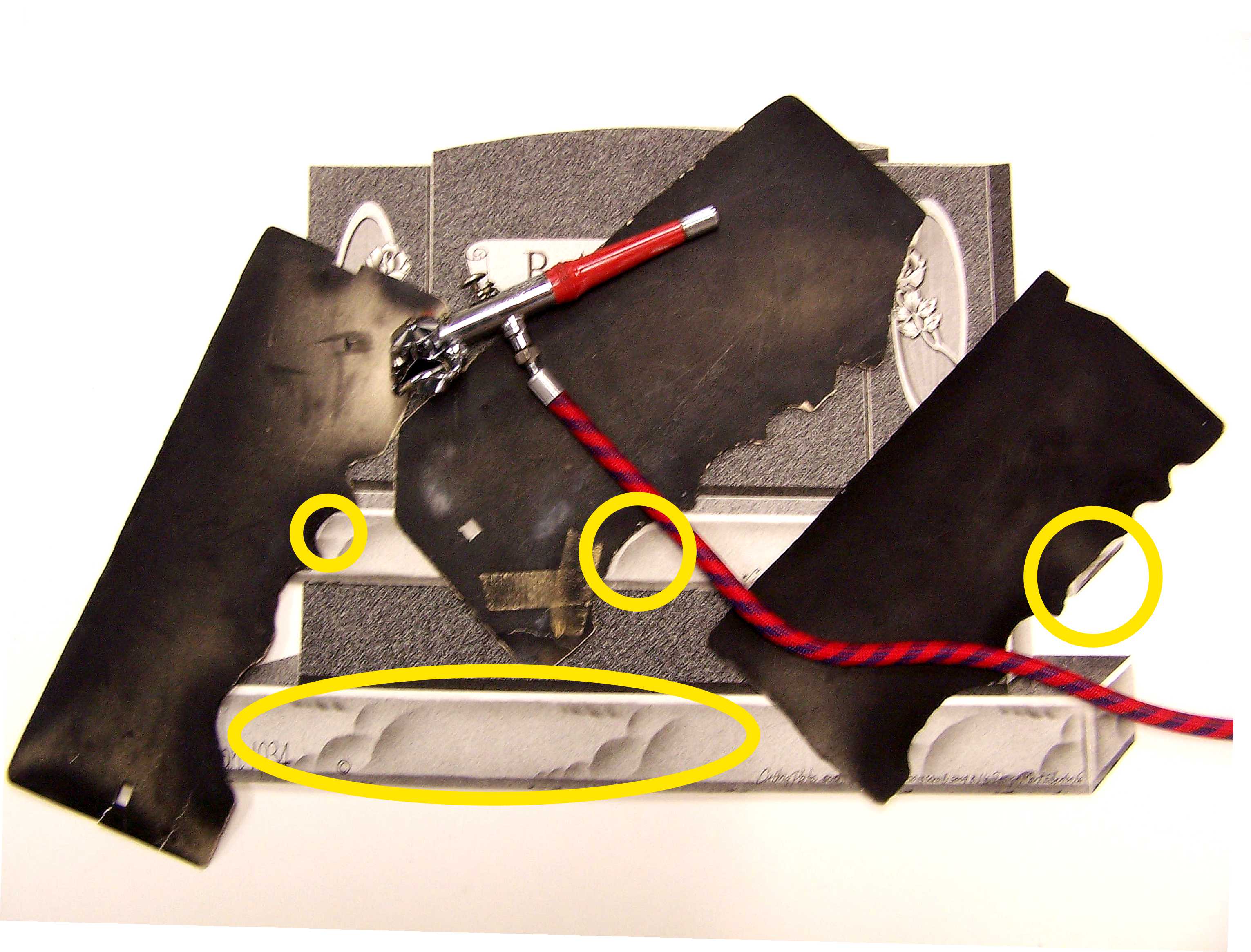
Rock pitch was applied at the end of the design process and was accomplished with a series of templates made from blotter paper. Joe Fernandez, and later, his son, Mike, tore small sections from the paper to form large, small, long and short curvatures. These templates were held against the water color and airbrush drawing and a specially tuned Paasche airbrush, with a tweaked mixture of water and black India Ink, was used to delicately apply a darker spray at the edge of the template - giving the illusion of a scalloped rock pitch surface.
These days it's much easier, and you can check out the new photo edited versions in our latest books, brochures, and our Online Monument Designer & Catalog.
In 50 years almost every aspect of the monument industry has changed. The one thing that remains the same is Design Mart's commitment to you and the families you serve. Design Mart has been adapting and growing with you for 50 years. From hand-drawn monuments to digital design, technology has changed, but Design Mart's mission is still the same: To help the retailer provide a personal memorial and the best service possible.
Old School Airbrush Drawings 1960s - Late 1990s
Before there were photo editing applications with airbrush features, artists like Joe and Mike Fernandez created drawings with sketchpads, tracing paper, pencils, pens, T-squares, triangles, curves, paintbrushes, rubber cement, thinner, airbrushes, ink, water, ink wash, finely tuned airbrushes, an air compressor, air pressure gauges, scratchboard, scraping tools, X-Acto knives, and lots of time. Each drawing, from conceptual sketches to the finished drawing, usually took several weeks to complete. This photo essay shows how hundreds of these drawings were created.
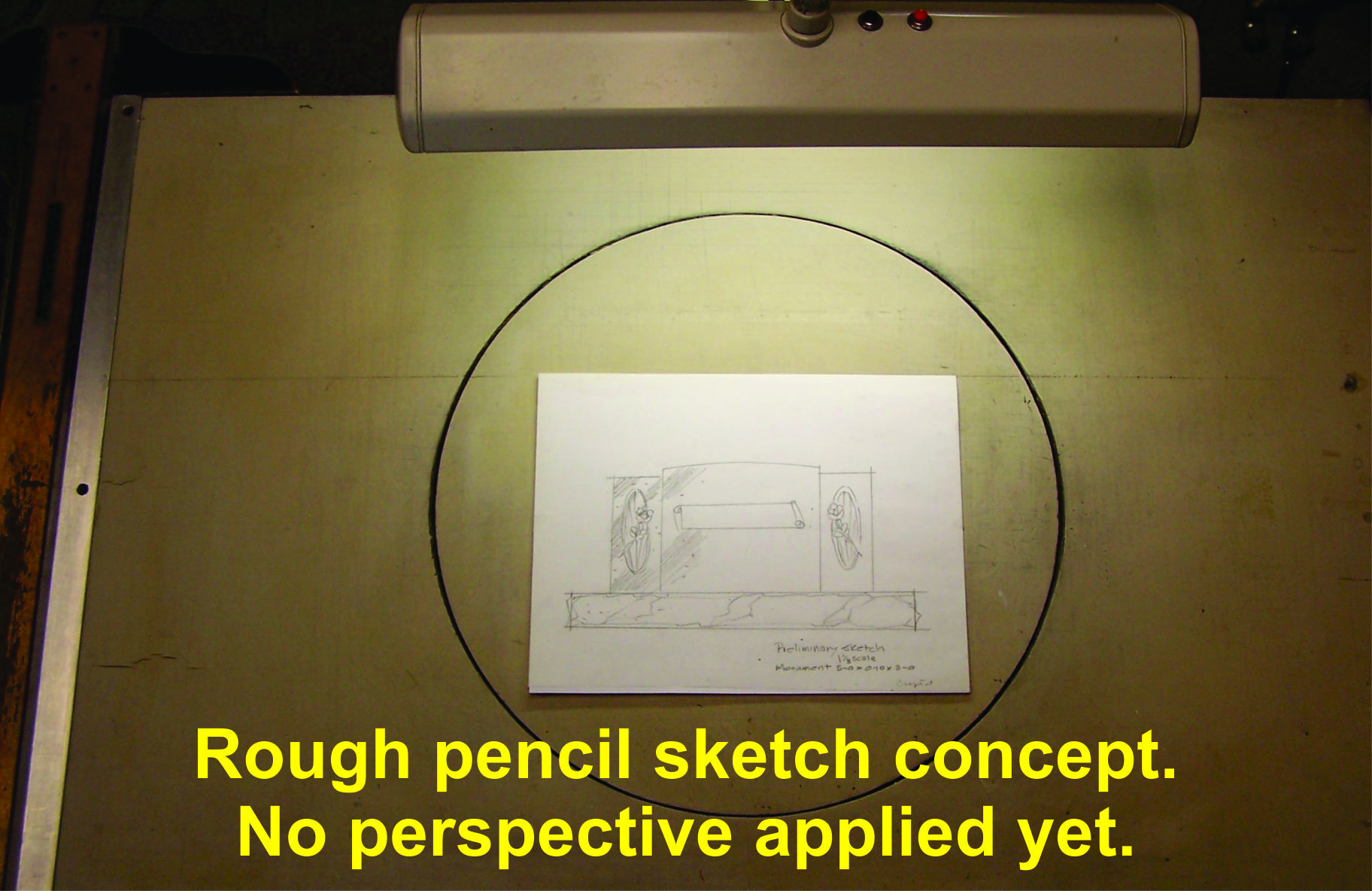
Each published design was the result of a dozen or more sketches. Sketches were evaluated, combined, and refined until a final sketch was on the board. Each drawing was created with harmony, balance, proportion, and symmetry (or asymmetry).
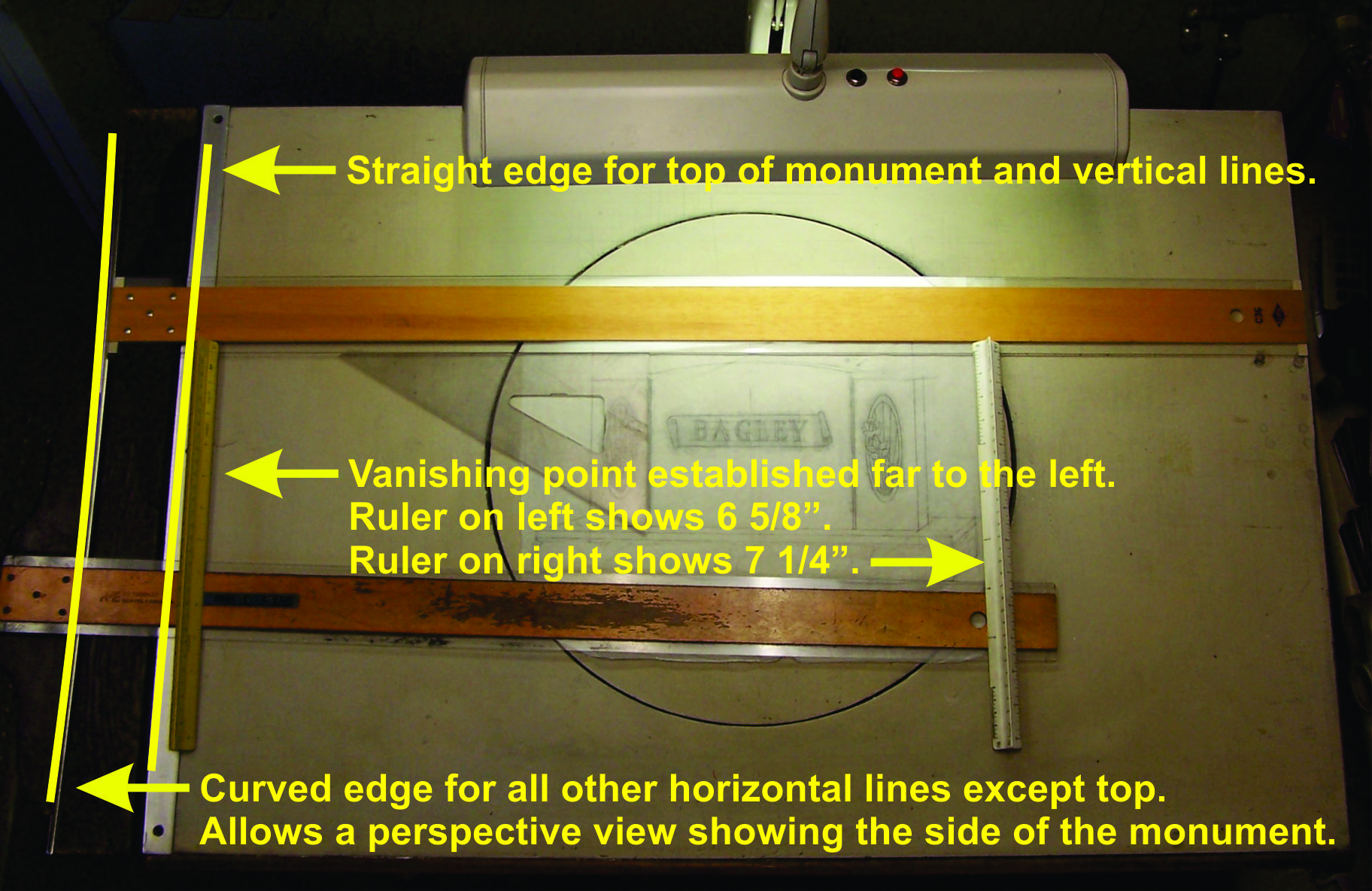
Design Mart designs are drawn in perspective...even with our new Online Monument Designer. Many old school artists, and many digital applications only show the front of the monument. It's much easier to do it that way, but a family purchasing a monument needs to see the side and top of the monument. The sides and top may be rock pitch (hewn), sawed, or polished. The family needs to know how their loved one's monument will really look from all angles. Since the side is shown, the drawing must be in perspective. In the same way that the lines on a highway vanish in the distance, a monument has a vanishing point. When viewed from the right, the vanishing point is to the left. A specially made, curved piece on the left side of the drawing board helps establish the position of a T-square to create a proper vanishing point.
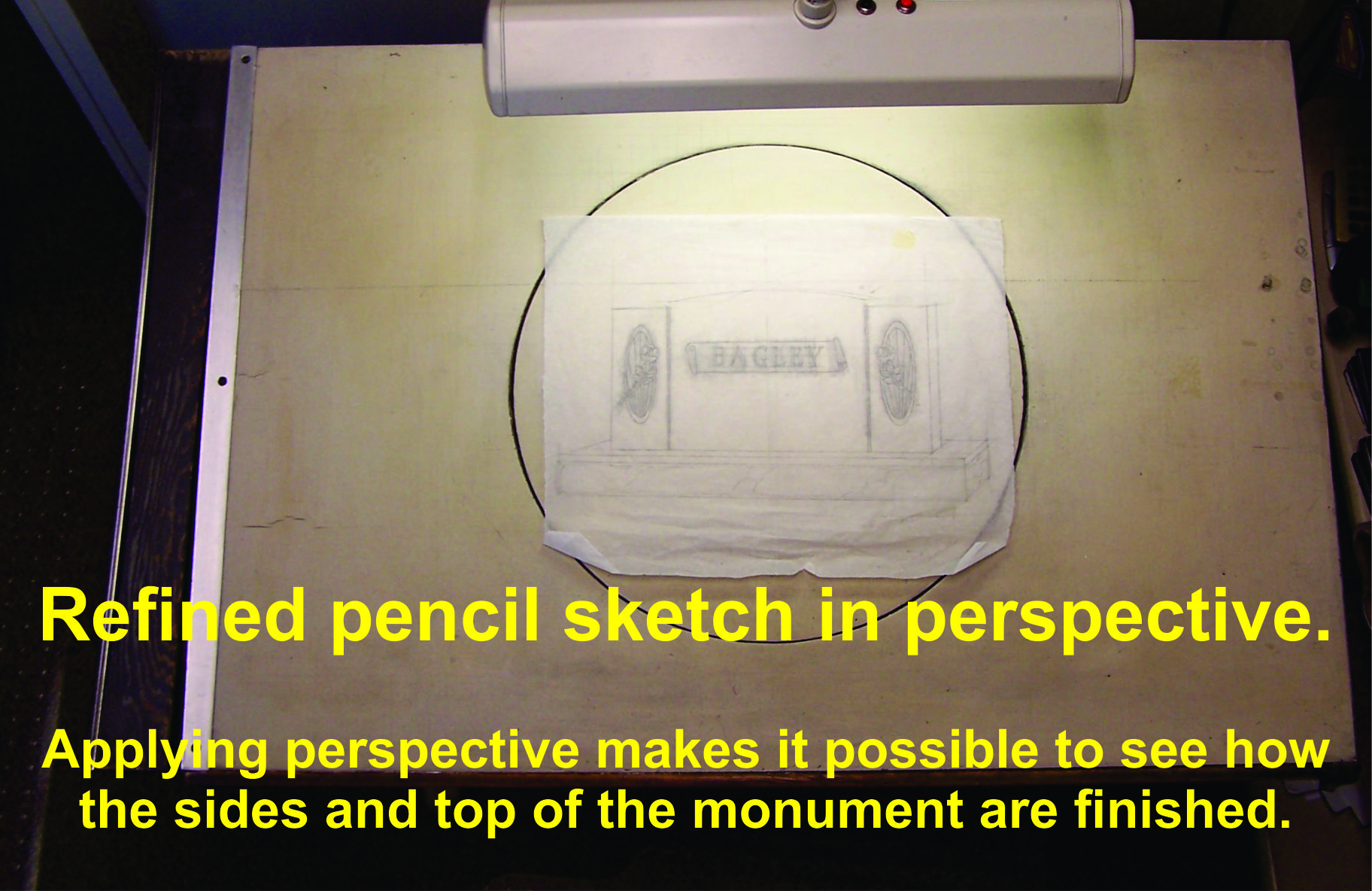
This is the last time the sketch will be used. A pencil will be used to apply a fine coat of graphite to the back of the drawing. Next it will be placed onto a piece of scratchboard. This is a piece of card stock or thick paper with a layer of chalk over it. This layer allows ink to be scratched off to create white highlights or correct errors.
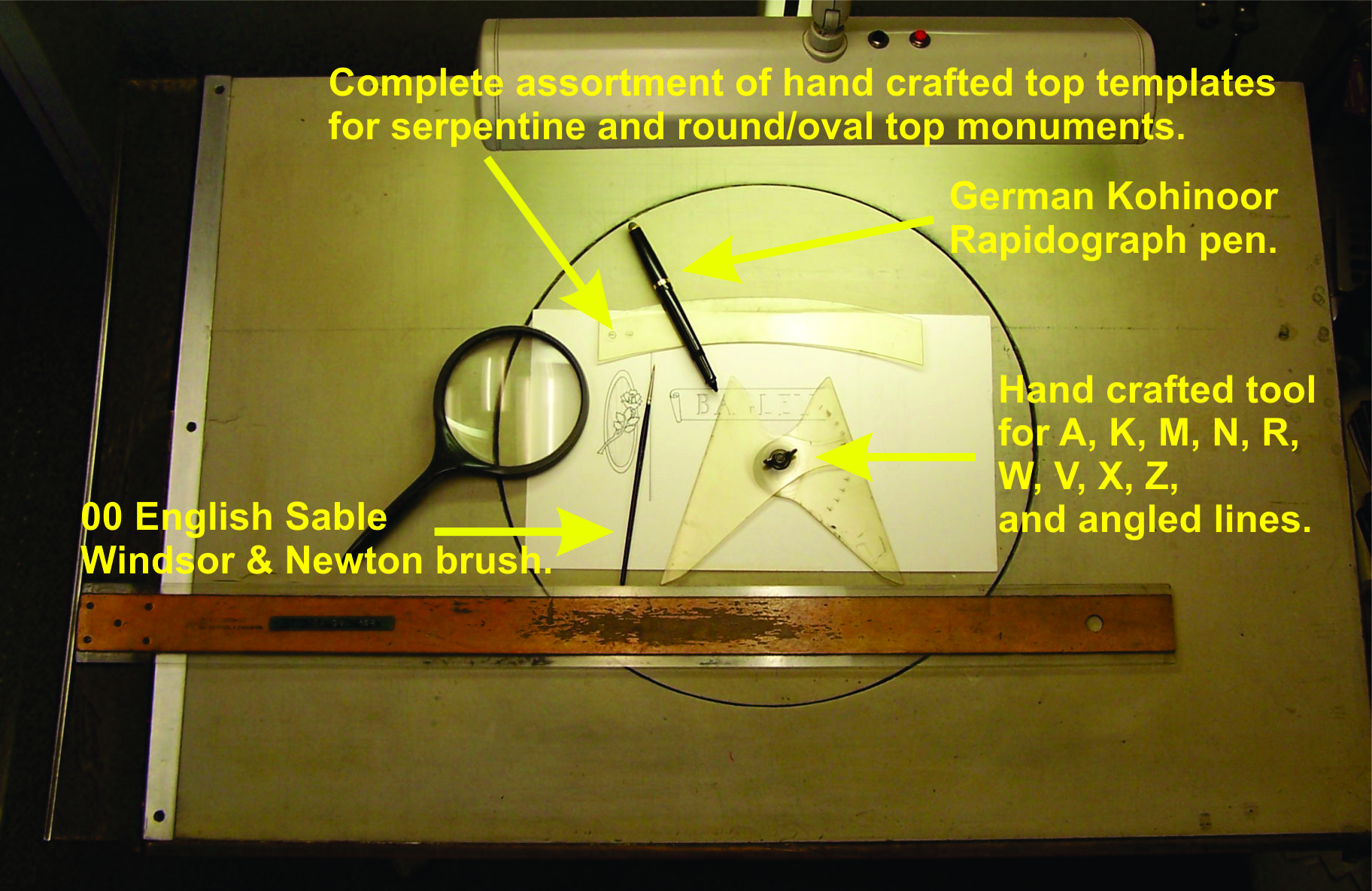
A handmade tool with a wing-nut allows the artist to draw all angled lines on letters at the same angle. Trying to hand draw two Ws with exactly the same angle without this tool would be nearly impossible. There are also many templates for the tops of the serpentine and rounded top monuments. From this stage on, no more pencils will be used. Everything is done with ink, and mistakes can result in lost time or a complete restart of a drawing. This tool is also used to taper the sides of the monument. Before the 1980s, the sides of monuments were tapered, making them narrower at the top. This gave monuments a more pleasing appearance to the eye as viewed by a visitor standing near the monument in the cemetery. A monument with straight sides would look top heavy if the sides were cut at 90 degree angles to the bottom of the monument. Think of holding a book in front of yourself and looking at the edge of the book. The edge closest to you will look larger than the edge that is farther away. In the 1980s and 90s more computer operated saws took over the operation of cutting a monument shape, and 90 degree (straight) sides were easier and faster to set up.
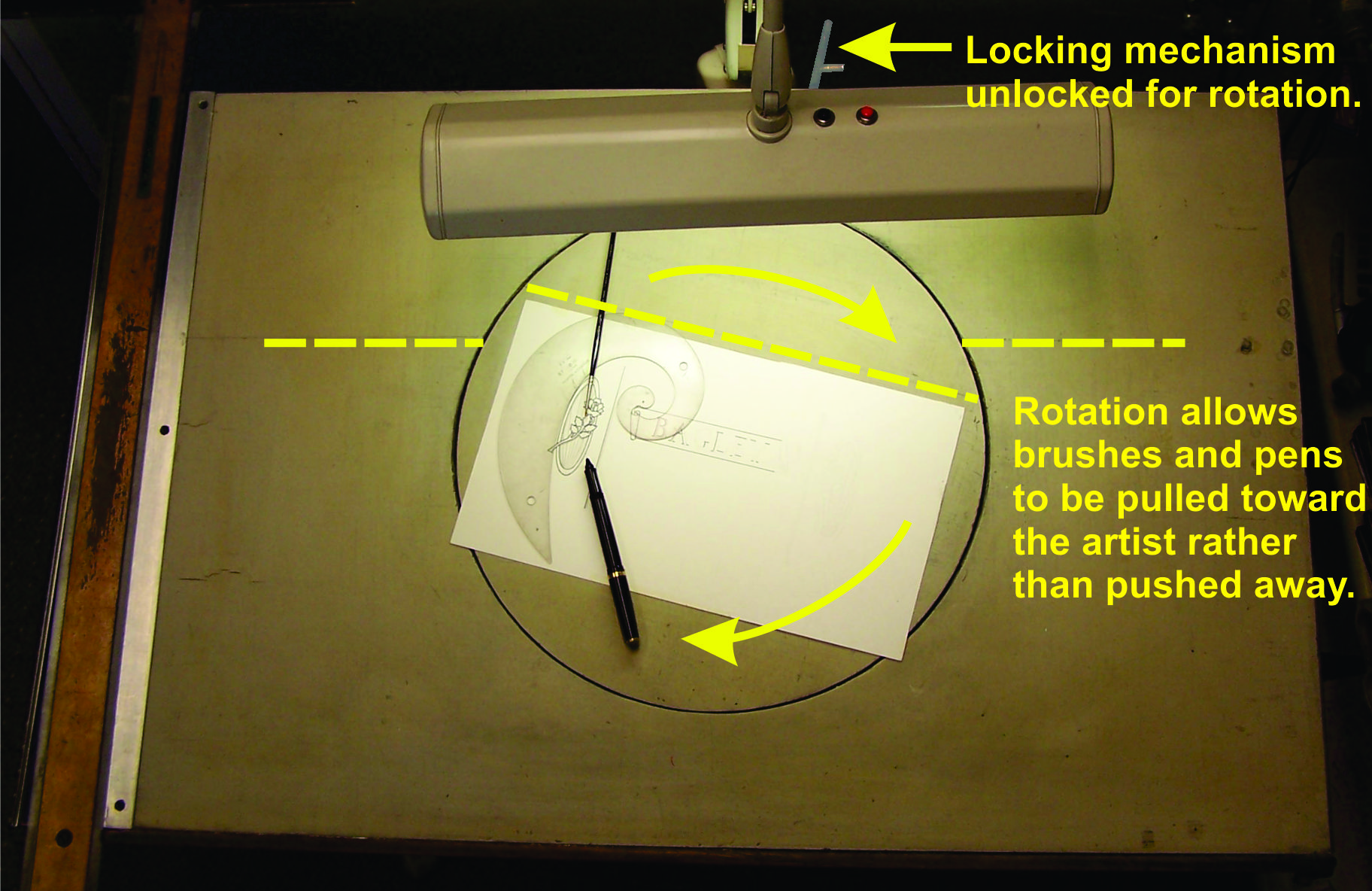
Think for a moment about painting or drawing. We pull pens, pencils and brushes toward us. We rarely push them. We have more control and visibility when pulling toward ourselves. This one-of-a-kind drawing board was built by Joe Fernandez. A locking mechanism at the top prevents rotation and locks in at true horizontal. Releasing the lock allows free rotation so brushes can be pulled toward the artist regardless of the direction of the line. The locking mechanism can prevent rotation while working or may be completely unlocked to allow free rotation.
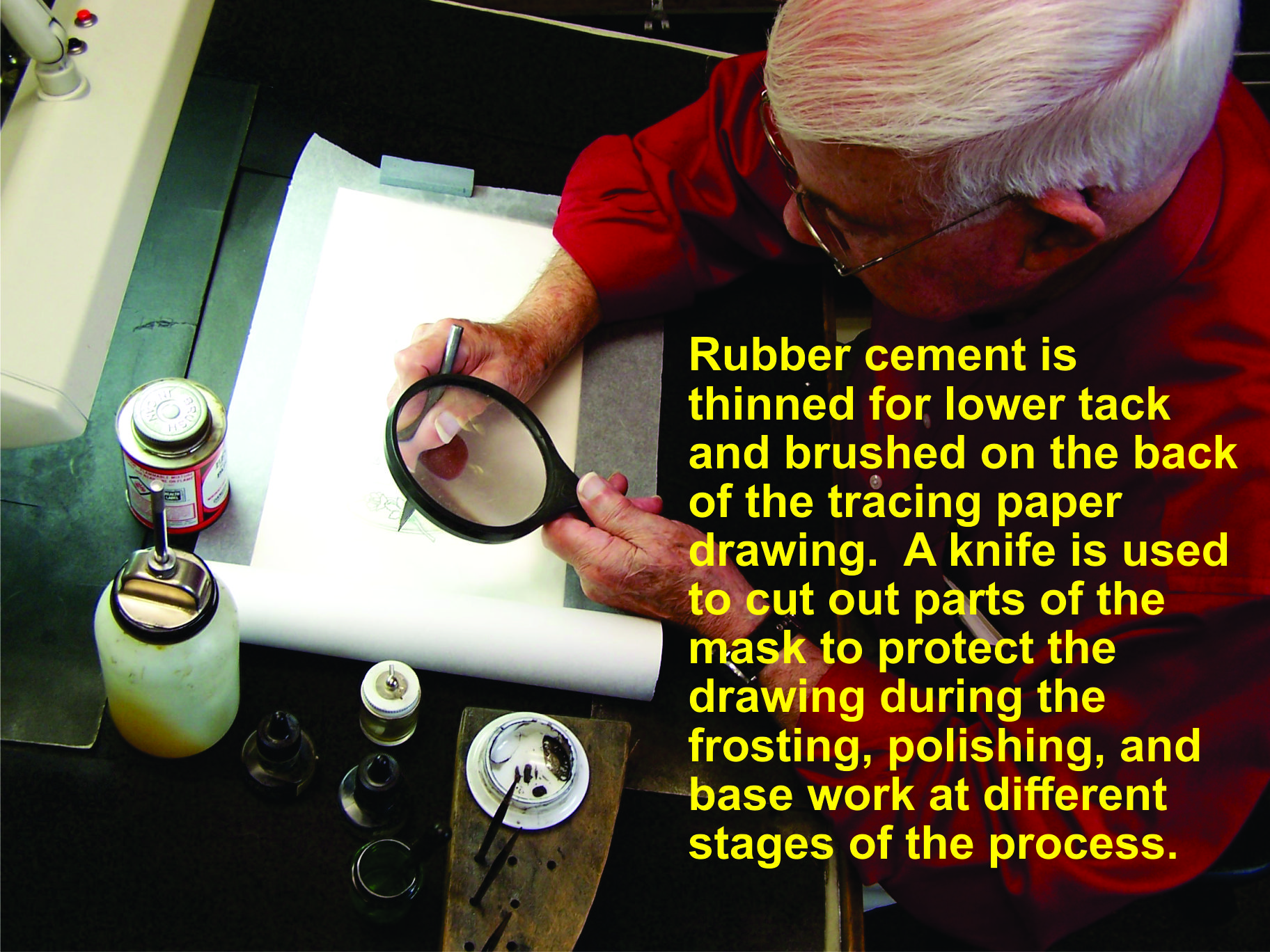
Masks must be created before airbrushing can begin. A new piece of tracing paper is selected, and a thinned rubber cement coating is applied to the back. Full strength rubber cement would cause the mask to pull ink from the scratchboard when the masks are removed. Tracing paper allows the artist to see the ink lines through the paper and cut an accurate mask.
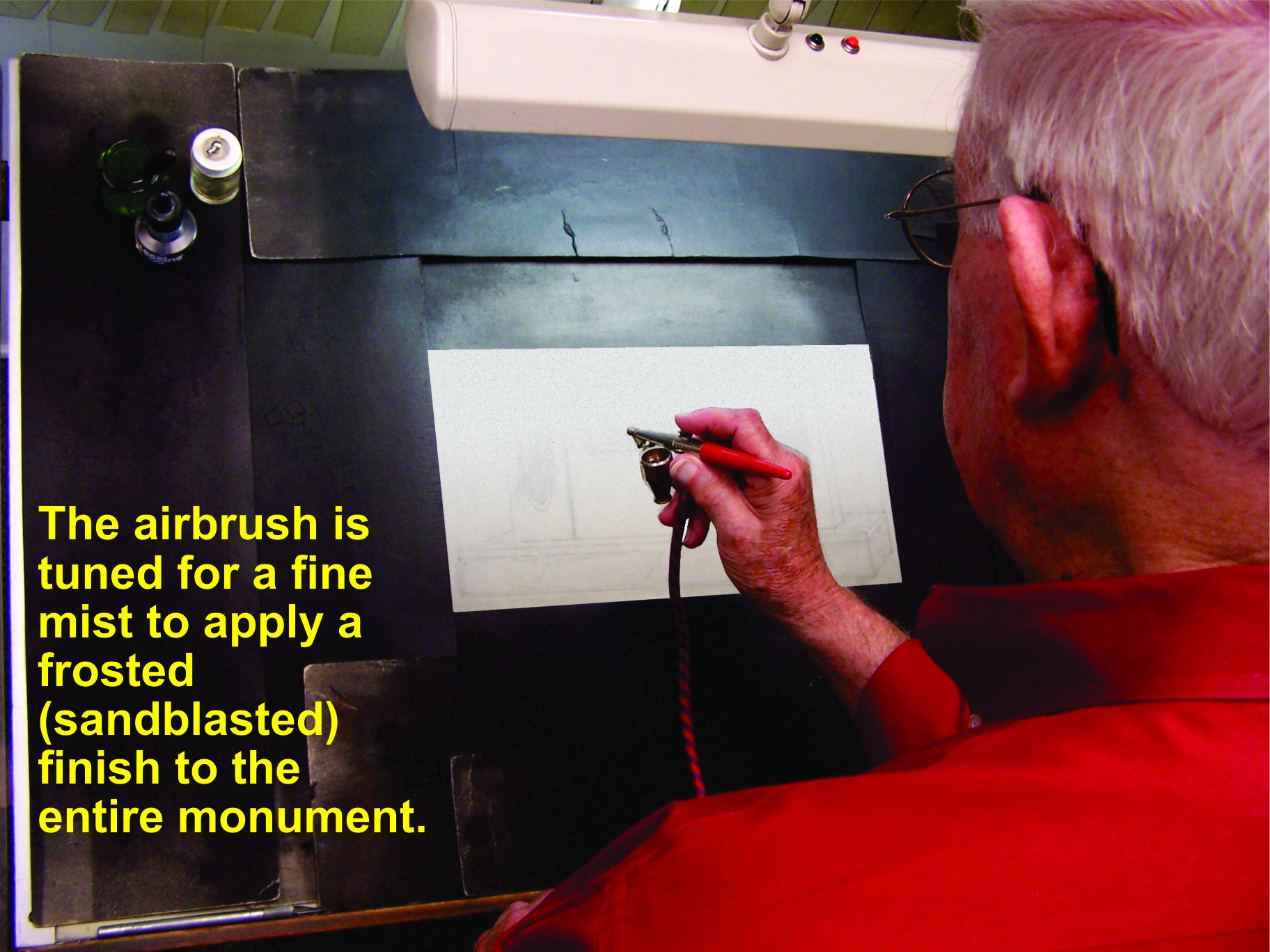
Two different Paasche airbrushes are used. The first one is set to produce a fine mist to simulate the frosted surface of the granite. This is applied to panels, flowers, etc.
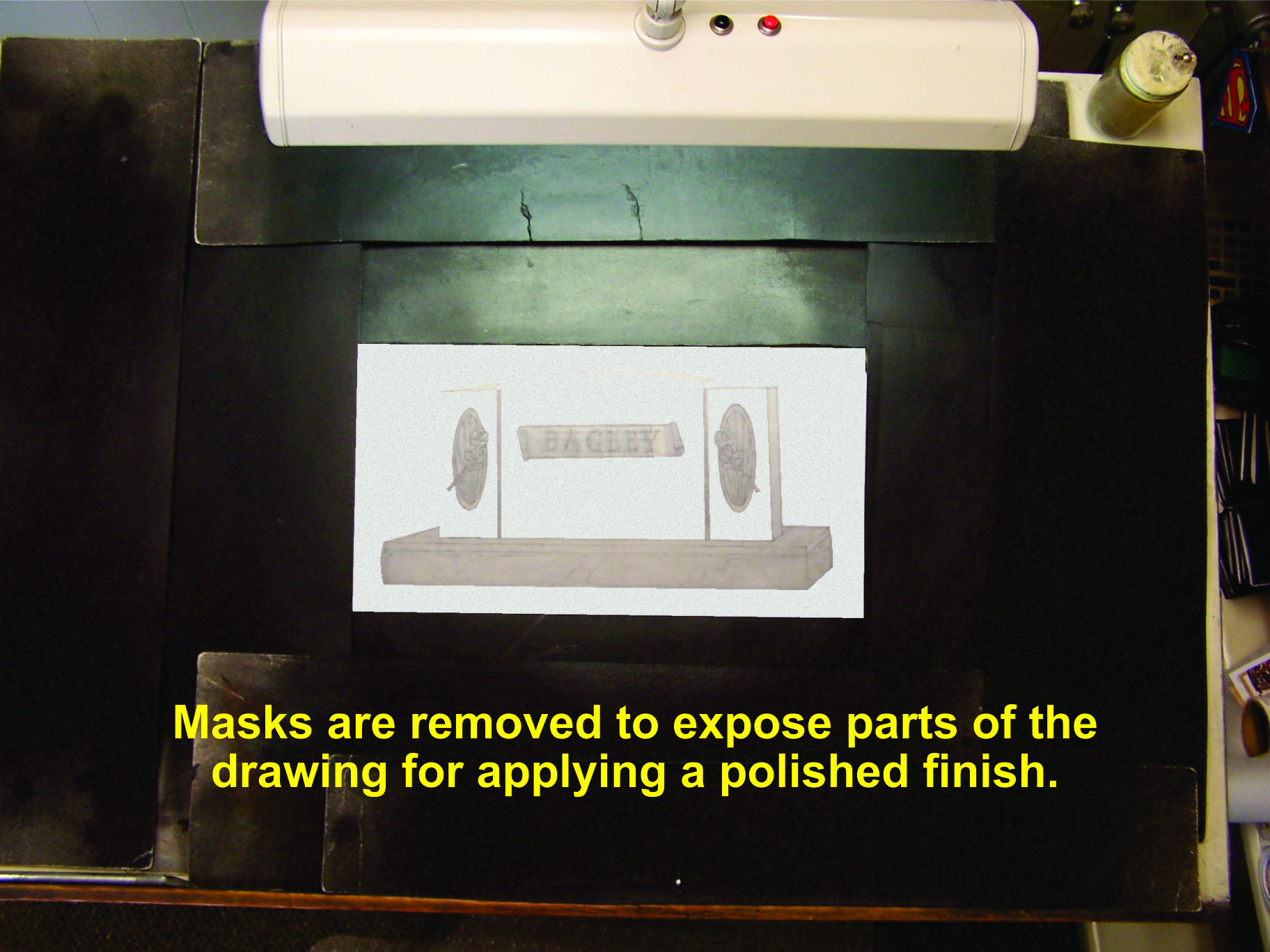
Masks are applied to portions of the drawing where frost needs to be protected and no polish applied.
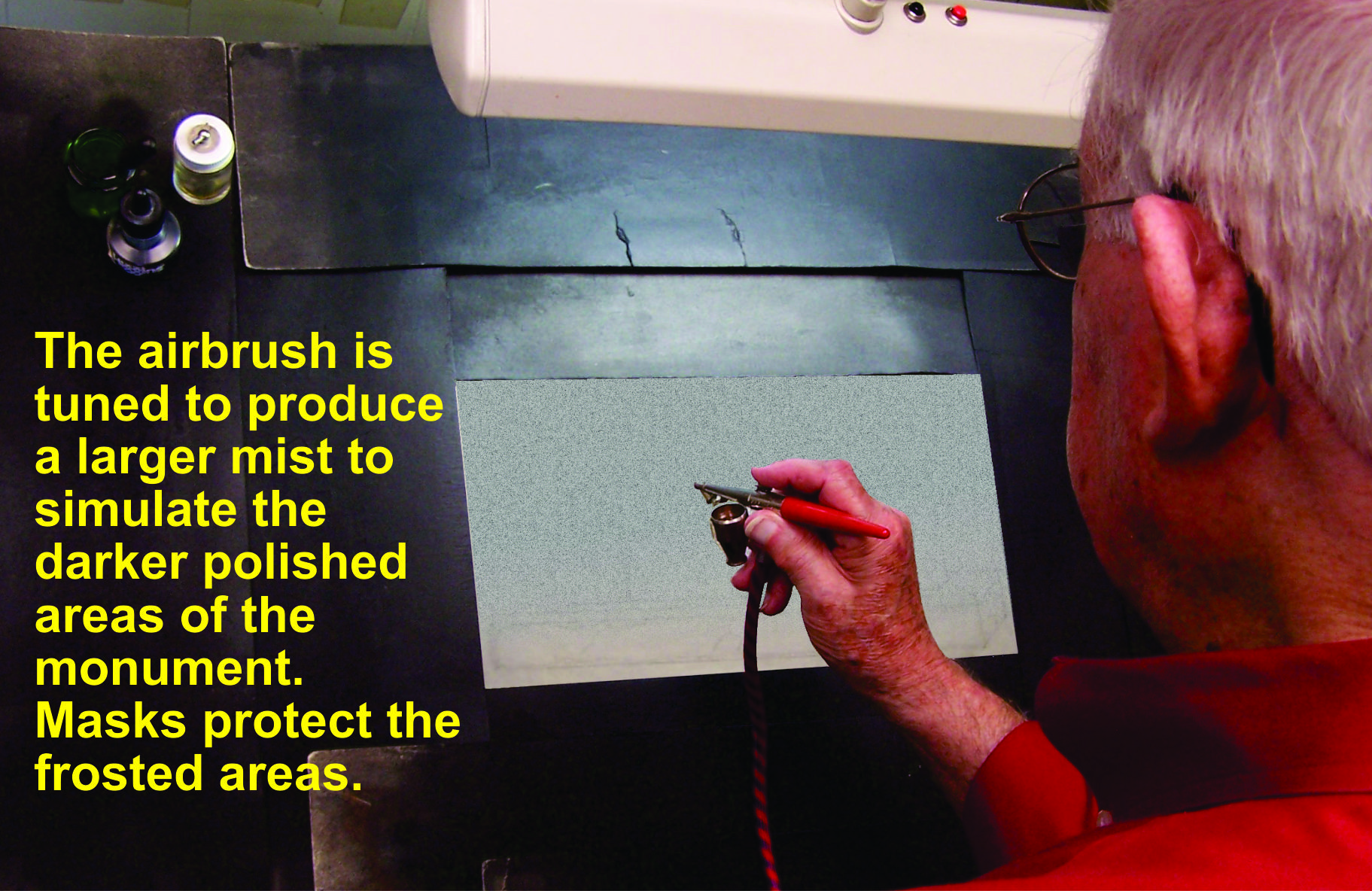
The second Paasche airbrush is tuned for larger dots of ink, which simulate the darker polished finish of the monument.
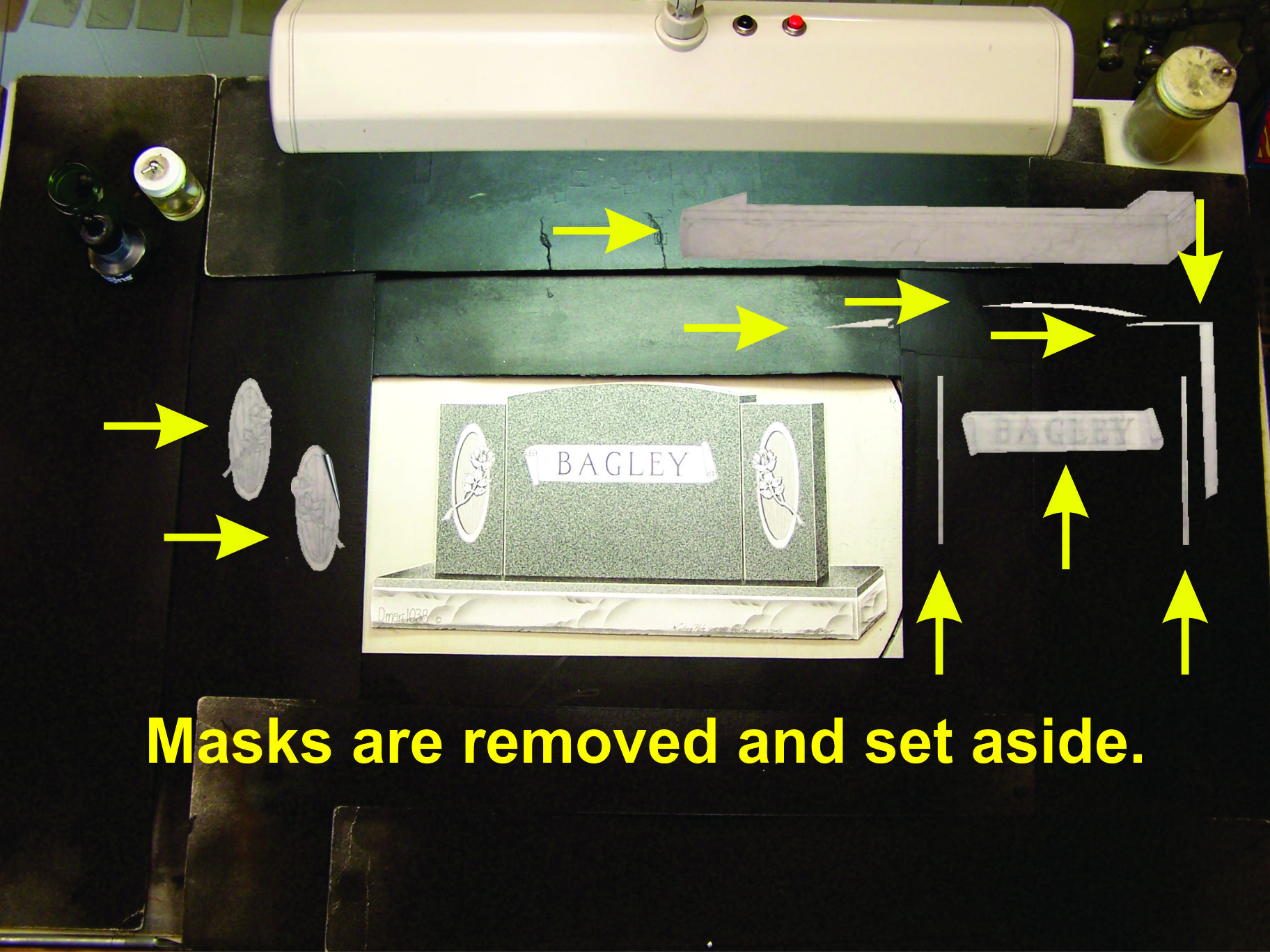
Masks are kept briefly while touch-up work is done. There's always a chance a mask may need to be placed back in position for additional airbrushing.
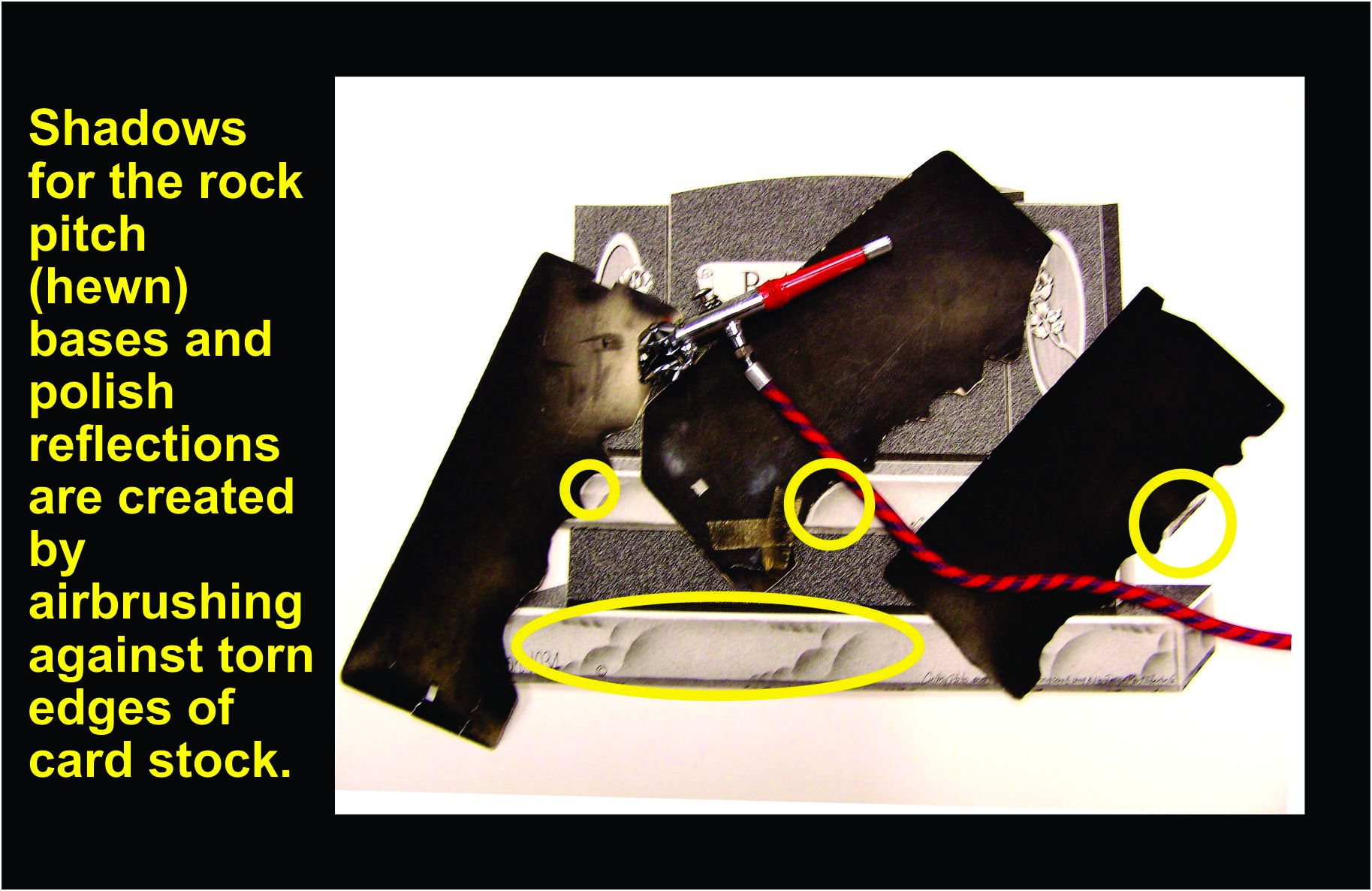
Bits are torn out of thick card stock and a fine mist is sprayed against the edges to simulate the rock pitch or hewn front edge of a base. These pieces of paper have been used since Design Mart opened in 1969.
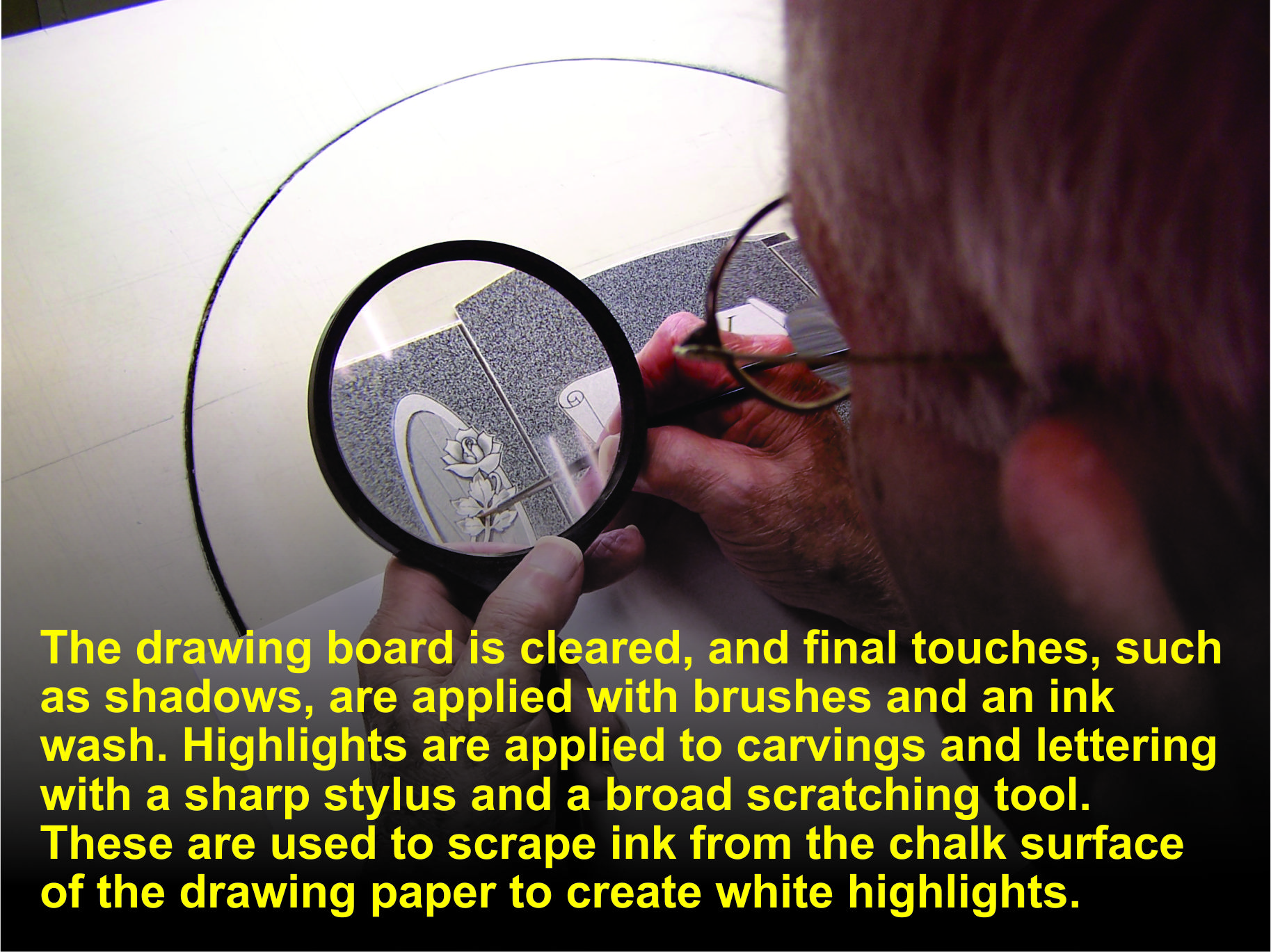
In the final steps, shadows are applied with an ink wash and a tiny brush. Highlights are applied by scratching ink off of the chalk scratchboard to reveal white underneath. Sharp lines, such as the edges of letters, were done with a stylus, while larger areas such as leaves and flower petals were scratched with a broader scratcher with tiny teeth or serration. Both tools were handmade by Joe Fernandez from used dental drill bits. Because the steel was good quality, the tools could be used for years with no sharpening required.
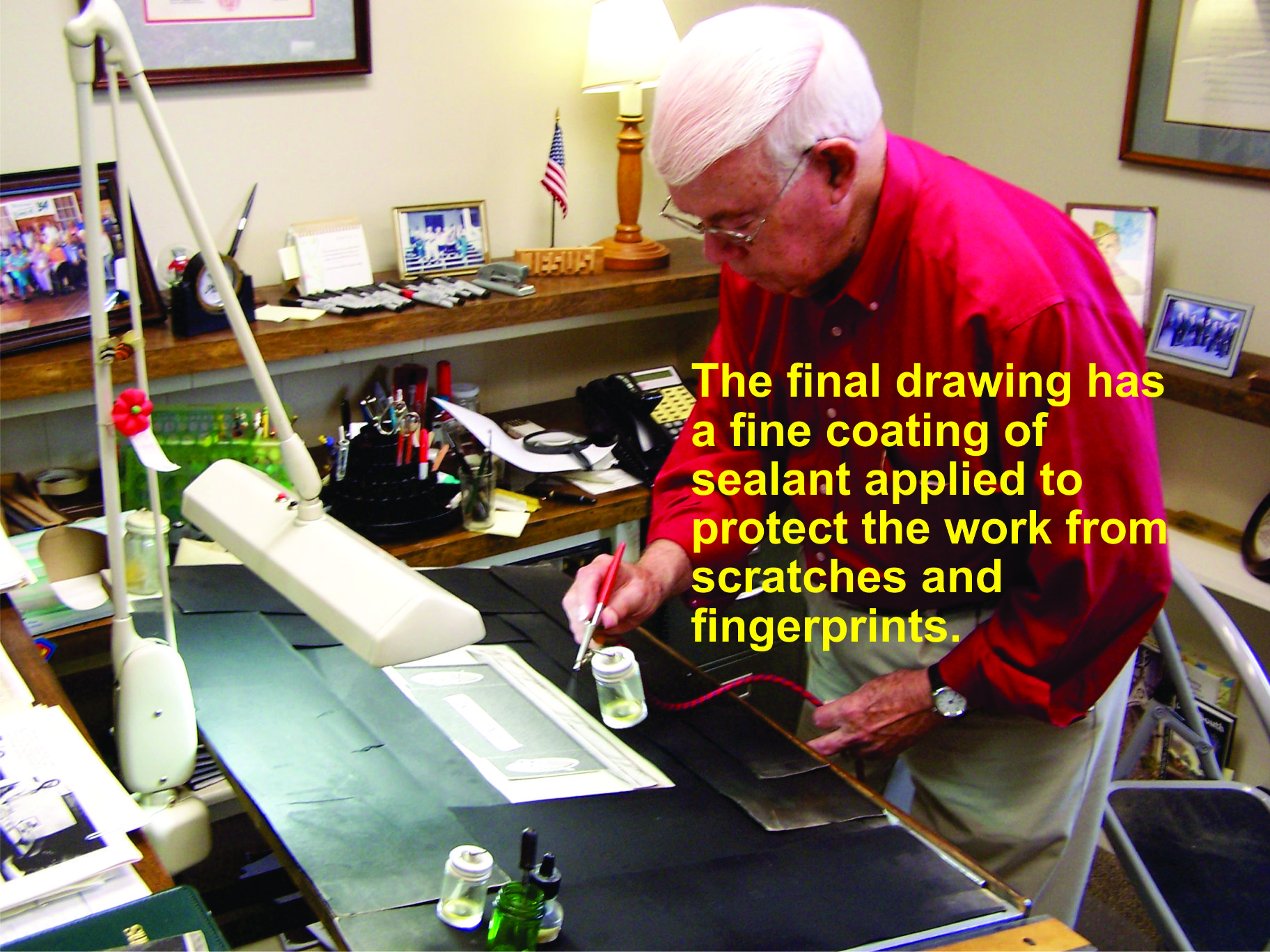
A coat of transparent "fixative" was applied to help resist fingerprints, and protect the drawing from scratches.
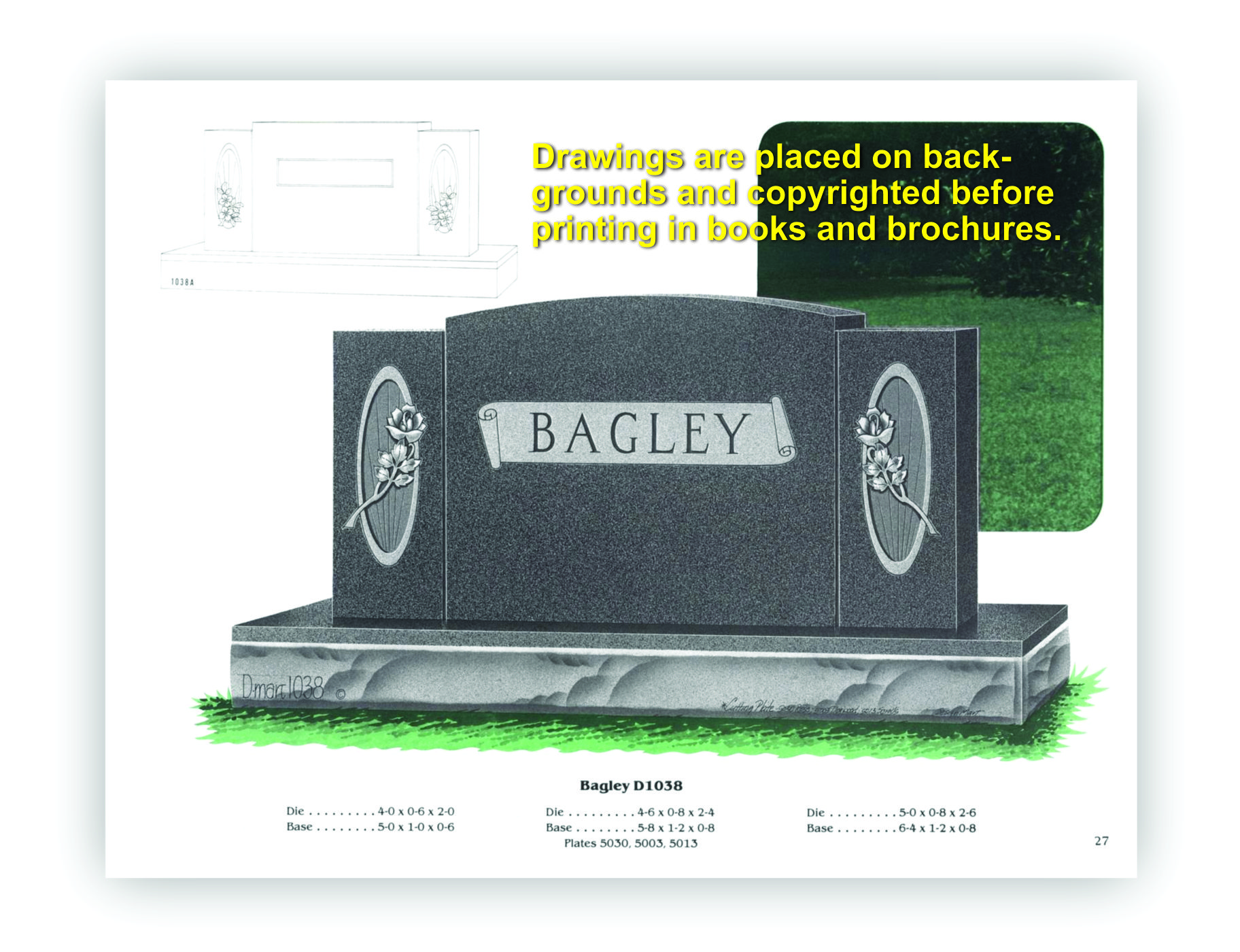
Drawings weren't placed on full backgrounds like those from other artists. Joe always believed the background shouldn't take away from the monument itself. Most drawings had alternate drawings shown in the top left corner. These alternates often used the same flowers, but were shown in a different way. Each drawing had an identification number applied, and standard flowers and panels had numbers as well. These identification numbers as well as the copyright indicia were placed on the bottom right side of the base, while the DMart identification number was always placed on the botton left corner of the base.
Design Mart & Keystone Alumni Collaborate On Memorial Tribute To Legendary Coach Vince Dooley
Keystone Memorials of Elberton, Georgia, has constructed many granite projects on the University of Georgia campus including walls, an Olympic Memorial, an Alumni Memorial, bases for statues, several signs, and the popular statue of UGA's famous bulldog mascot located in Sanford Stadium. UGA alumnus Tom Oglesby and sons George and Ross, also UGA alumni, have collaborated on several projects with Design Mart in the past. Joe and Mike Fernandez, both UGA alumni, were glad to help with a design for a memorial to legendary UGA Coach Vince Dooley.
The design went through about 20 sketches and revisions before landing on the final concept, and some of those are shown here. After preliminary sketches by Joe, Mike presented different options for polished surfaces on the black monument. In the end, the Dooley name would be the only polished black surface. In addition, the family decided to change from acanthus shown at the tops of the columns in the original sketch (shown below) to a Bible, the UGA logo, the UGA arch, and a flower to represent the Dooleys' love of gardening (as shown in the final monument photos). Ross also worked with the family to revise the design to include crosses on the front and back of the monument.
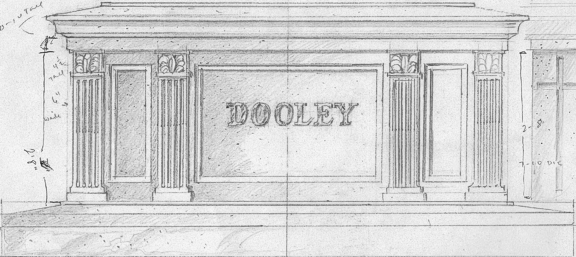
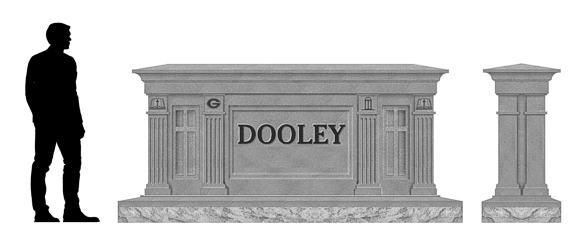
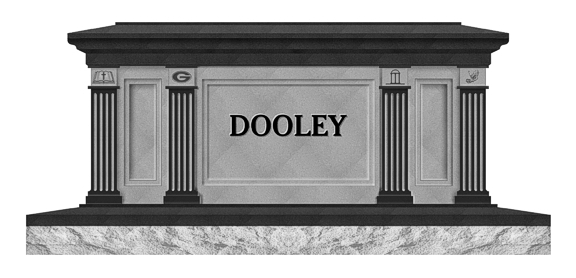
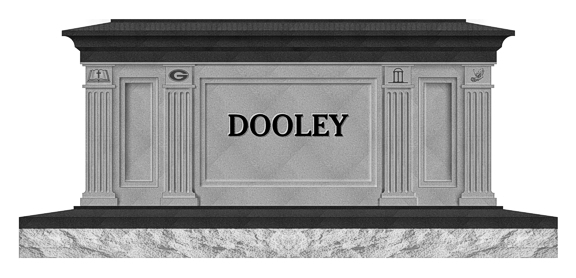
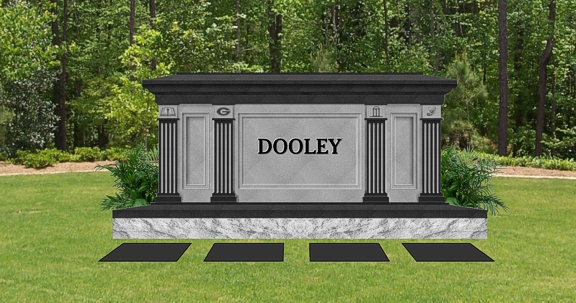
After the monument was set, Mike and his parents, Joe and Katherine, visited Oconee Hill Cemetery behind Sanford Stadium. Shown below: Joe Fernandez (UGA '68), and his son Mike Fernandez (UGA '87).
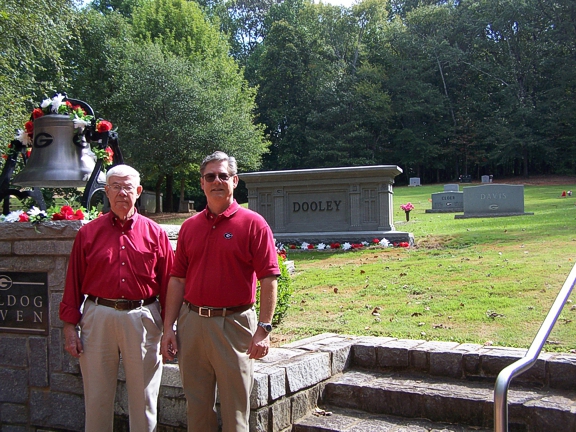
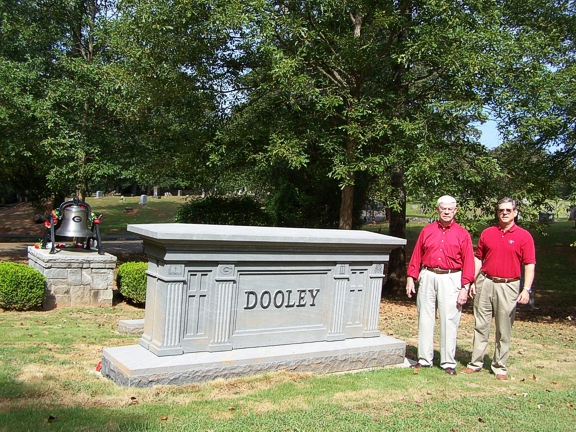
To visit the memorial in Bulldog Haven, enter Oconee Hill Cemetery behind Sanford Stadium, take a left, cross the river, then stay to the right. You'll eventually come to Bulldog Haven nestled in the woods.
Vince Dooley
Head Coach 1964-1988
Continued as Athletic Director until 2004
Overall 201-77-10 record
1 National Championship - 1980
6 SEC Championships
Inducted into the College Football Hall of Fame in 1994
Died October 28, 2022
Buried at Bulldog Haven section of Oconee Hill Cemetery on November 3, 2022 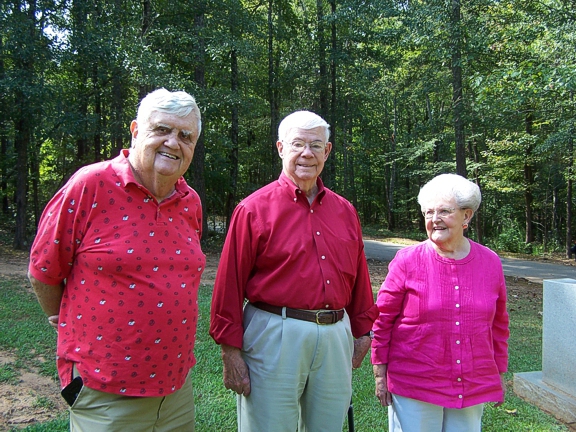
As the Fernandez family was taking a few photos and paying their respects, a '66 letterman from Pennsylvania, Jim Massey, drove up, and there was a reunion of old Dawgs.
Fernandez Monument Featured In Summer 2024 Issue Of The EGA Graniteer Magazine
Fernandez Monument Featured In Summer 2024 Issue of EGA's Graniteer Magazine
Joe and Katherine Fernandez, founders of Design Mart, recently saw the completion of their preneed monument by Keystone Memorials, of Elberton. The design, first conceived by Joe more than 60 years ago, has been one of his favorites for all these years. Thanks to Mona Agnew of the Graniteer magazine for this news and tribute to Joe and Katherine.
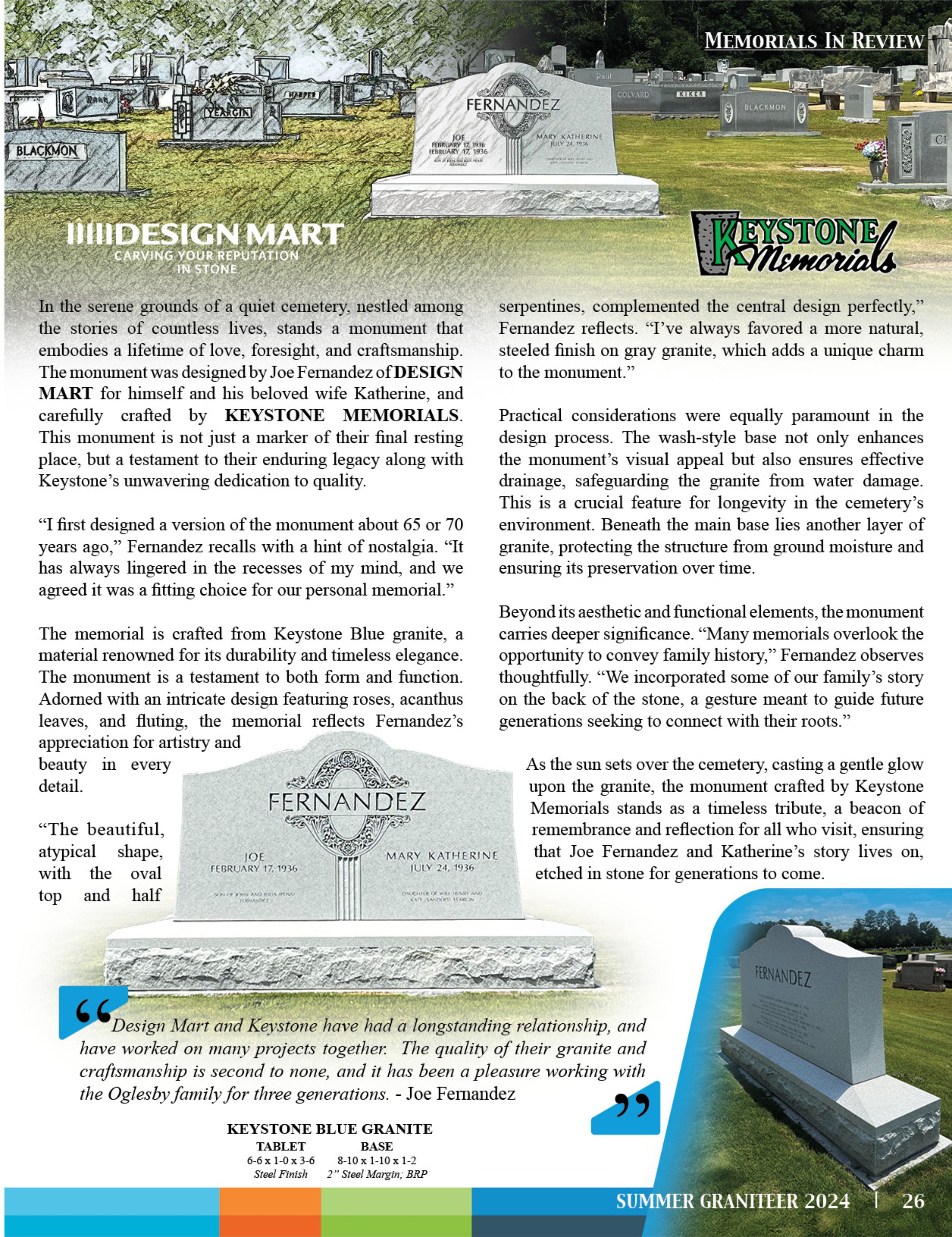
Happy 89th Birthday, Joe!
In 1953 Joe Fernandez started working at Coggins Granite in Elberton. After serving in the Army and returning home he opened Design Mart - while also earning his Bachelor's of Business Administration from the University of Georgia. He later sold Design Mart to his son, Mike, but all these years later he and his wife and co-founder Katherine are still coming in every day. Joe is shown here with a blueprint (old school copy) of an architectural piece he drew for a hotel on St. Simon's Island while still in high school.
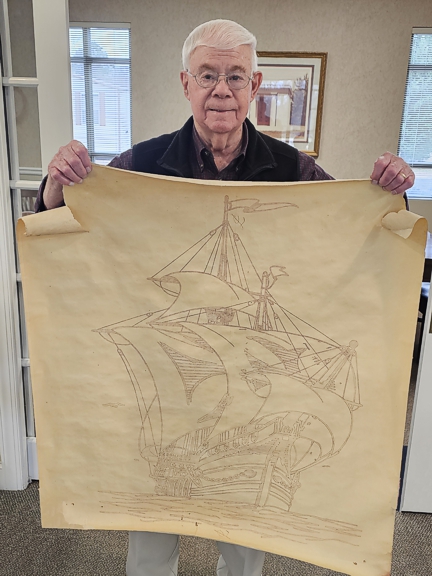
He transitioned to computers years ago, but there's no cut and paste for him...still working with a pen in hand. Keep it up, Joe! Happy 89th this month!
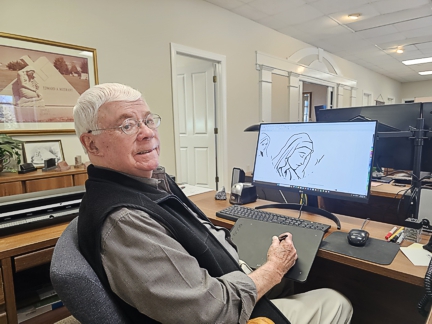
How Memorial Day Got Its Start
As you would expect, there was much healing for our nation to do at the end of the war between the Confederate States and United States. In fact, Confederate soldiers' grave plaques were inscribed in Latin, with Deo Vindice or God Will Vindicate. Clearly, there would be deep wounds for generations to come. Design Mart's Mike Fernandez is shown here explaining one of the plaques to a recent Elberton Granite Association class.
Originally know as Decoration Day, Memorial Day originated in the years following the war when families gathered to decorate the graves of fallen soldiers. During the first celebration of Decoration Day more than 5,000 people decorated the graves of more than 20,000 Union and Confederate dead at Arlington cemetery. This  event, in 1868, was inspired by many local celebrations in communities during the three years following the end of the war.
event, in 1868, was inspired by many local celebrations in communities during the three years following the end of the war.
After World War I our nation began to remember those who had perished in all wars. In 1966 President Johnson named Waterloo, New York, as the official birthplace of the celebration since they had made an annual event of it. In 1971 Congress declared the last Monday in May to be Memorial Day.
Modeling & Sculpting Before The Digital Age
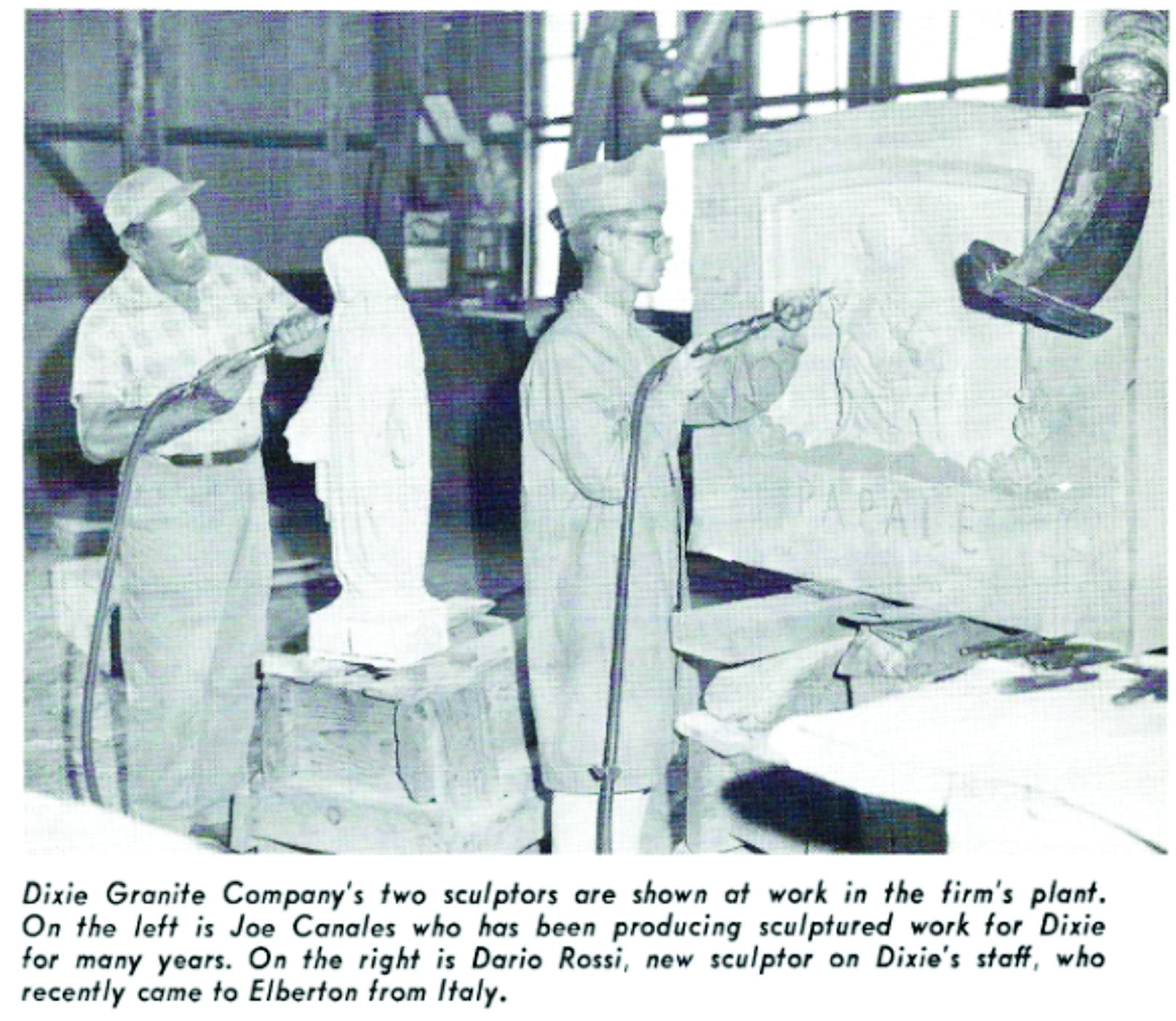
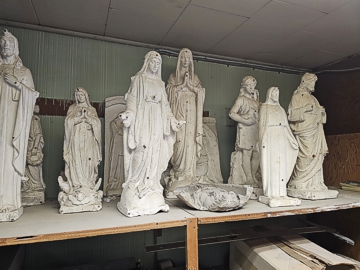
Master Sculptor Dario Rossi worked many years in the former Harmony Blue plant in Elberton, Georgia. His Italian roots and spirited demeanor were his trademarks, as were his hats he wore from the Varsity restaurant in Athens and Atlanta. These paper hats, worn by cooks and cashiers, were made of paper, and had a paper top that allowed Dario's head to stay cool while keeping granite dust out of his hair.
Shown in the old photo is Joe Canales, working with Dario (right) who was only 28 years old at the time. He worked and attended art schools in Italy for 15 years in. His family would join him in Elberton a few years later.
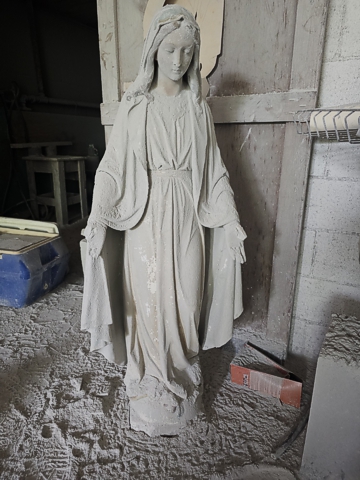
While working he used miniature models that had nails located in the ears, noses, and other important points on a figure. With a set of calipers, he would multiply the distance between two nails, reset his calipers to life size, mark the stone, and go to work.
Shown here are some miniatures as well as a life size plaster model from which Dario Rossi worked long before the age of 3D modeling and CAD, CAM, and CNC. We hope you find this as fascinating as we did!